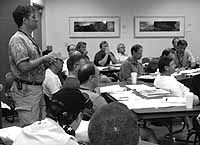| Andy Pullam, one of the Nautilus instructors, works with some of the geologists here this week in a classroom at the CEU Prehistoric Museum. While class work is important, it is the field trips that truly educate those who come to the area. Leaders of the group say that this is one of the best places to teach people about beaches. |
When most people think of the word Nautilus, they think either of the submarine out of a Jules Verne novel or a marine creature that lives in a shell in the ocean.
But for many geologists, that word means an education program that teaches them about the worlds ancient beaches.
And one of the favorite places for the Nautilus program to train these men of science is right here in Carbon county.
Beaches in Carbon county?
“The bookcliffs are one of the best places in the world to teach these guys about coastal environments,” says Lee Krystinik who works with the organization. “This area has many beaches that are 80 million years old and we can see how things in the world changed over time. I can stand in one place and know I am standing at a spot in time and then move and find another spot in time when things changed.”
Every year for years Nautilus has been bringing people to Carbon county from all over the world. Last week there were geologists in town from many different corporations. This week those that have travelled here are from one company.
Nautilus was started by the pioneering geologist John Bosley, who was one of the first people to really study the bookcliffs in the 1960’s and 70’s.
“Bosley was one of those guys who was a pioneer and a mentor,” says former CEU Prehistoric Museum Director Don Burge. “I learned so much from him and he was key to a lot of things that are going on in geology today.”
Krystinik, who also learned a lot from Bosley, says he is fascinated with the fact that geologists can walk on rocks and coastal plains that Dinosaurs strolled on during the Cretaceous period.
“I’ve always tried to imagine what the forests sounded like in those days,” he says. “Think of the noises some of those animals made.”
The best thing about visiting here says Krystinik is that geologists don’t have to theorize about how things changed over time. They can see it in all the structures that still exist.
But he isn’t just impressed with the rocks in the county. He loves the prehistoric museum too.
“Your community is fortunate to have this museum,” he states. “It is so much better than many in much larger cities. This is a real jewel.”

